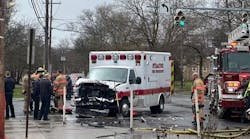Today's firefighters deserve the very best when it comes to safety, accountability and location technology but are presently far from the ideal technology.
Recent reports demonstrate problems with Personal Alarm Safety Systems (PASS) warning devices that are worn by firefighters. PASS Products currently on the market have failed in on-scene operation at temperatures below 500 degrees Farenheit which may have impacted injuries and fire fighter deaths.
Firefighters know about the problem and the International Association of Fire Chiefs (IAFC) has advised their members about the problems and urged them to test their PASS devices. The IAFC and other fire service agencies are also working with manufacturers to fix problems with the PASS devices to protect firefighters lives.
Problems that have been identified with existing PASS alarms:
- Low temperature housing - system can fail prematurely
- No external Thermal Couple. Design makes use of an internal temperature sensor.
- Since the casing has a low-temperature failure, the system cannot withstand temperatures even half of flashover temperatures
- The PASS alarm only monitors the temperature from a single point on a scale of zero to 350 degrees Farenheit.
- Current PASS devices stop working after five minutes at 500 degrees Farenheit.
- The system does not monitor vital signs of the firefighter; Firefighters will show signs of stress before they stop moving.
- The current PASS alarm concept only monitors for movement as a determination of a "Fire Fighter-Down" event causing frequent false alarms
- The concept of the current PASS alarm was to associate lack of movement with danger, consequently there are a significant number of false alarms ultimately causing the alarm signal to be ignored.
- The PASS alarm does not have a heads-up display interface indicating internal/external temperature and/or firefighter stress level, which would put information clearly within the line of sight.
- Pass devices currently in use attempts to use a "beep" alarm to signal a problem and does not communicate directly with the adjacent firefighter. The signal only goes back to the command center display panel if that.
Recently I met Bruce Schmutter with WM Industries and reviewed a new concept called FireTeam-Link which shows much promise for firefighter safety. I was so impressed that I felt moved to share this concept with the fire service in hopes that it will further influence the evolution of this technology.
This new product concept provides the following information:
- Monitors internal and external turnout gear temperature at six location points on the Fire Fighter (arms, legs, torso, and self-contained breathing apparatus (SCBA)
- Monitors vital signs including heartbeat and respiration
- Will monitor a Fire Fighter's location by X-Y-Z coordinates in conjunction with another product called FireGround Reconnaissance System.
- Full voice communication amongst the individual company and command.
Information is transmitted and disseminated over a wireless hierarchal mesh network. The FireTeam-Link monitors the temperature, pulse, and status of the firefighter to tell him/her, the members of the team, incident command, and central dispatch if the Fire Fighter is in danger of potential exhaustion or collapse.
Reliability is a key concern and is ensured by the following methods:
- Keep-alive validation and plausibility check on vital signs and other life-safety crucial systems.
- ZShield thermal fortification, Contact-less, wireless, self-monitoring, built-in battery charging. The WMI FireTeam-Link will remain fully functional at temperature of 2000 degrees Farenheit for 1 hour.
The FireTeam Link consists of the following equipment:
- ZShield Thermal Fortified Portal Logics' transceivers/thermo couples incorporated into turnout gear arms, legs and SCBA mounts
- Wearable vital signs monitoring system and wireless headsets as well as having built-in capability to display information about the surrounding temperature partner firefighter's status directly on the faceplate of the helmet, in a display similar to that found on a fighter pilot's helmet.
Presently WMI is having discussions about testing the technology with Ventura, CA, Fire Department as well as ongoing discussions with NIST.
Ernie Mitchell, retired fire chief, former IAFC President and presently working with the Center for Technology Commercialization had this to say about the technology, "For the past three years I've been involved with organizations that discuss, review and contribute to the development of new technologies that may enhance the health, safety and operations of first responders. I'm very interested in seeing improvements move forward and become available to first responders, especially firefighters. Unfortunately, though money and time have been spent for research intended for those purposes over the past few years there have been relatively few user desired improvements coming to market. My sense is that your projects could be developed and available in a shorter time frame than many others and that are still in research and for me that is the bottom line. We need practical solutions to emergency operations problems and we need them to function as marketed. I believe yours have that potential and that makes them exciting for me."
For more information or to express interest in testing the technology, contact Bruce Schmutter or WM Industries:
WM Industries
182 Plymouth Street
Brooklyn, New York 11201
Phone: 718-246-2626
Fax: 718-246-2455
E-mail: [email protected]





